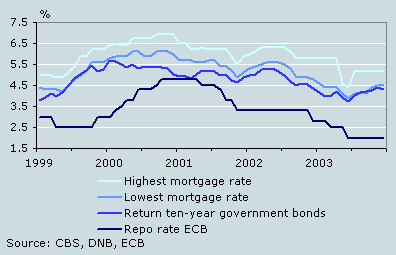The influence of the ECB raising the interest rate on the capital market

The Governing Council of the European Central Bank (ECB) raised its interest rates by 0.25 percent on 1 December 2005. It is the longest period between ECB rate changes ever. The previous rate change was on 6 June 2003. In the past, the ECB rate changes never greatly influenced the interest rates on the Dutch capital market at the time they were introduced.
Raising the interest rate to retain price stability
The interest rate on the money market, including the repo rate, is the ECB’s main instrument to maintain price stability in the eurozone. The money market is the market for short-term credit. According to the ECB there is price stability when the inflation rate is about 2 percent.
In 2000, the ECB raised its interest rates several times because of inflationary pressure. At the time, the hike in oil prices and the depreciation of the euro on the US dollar raised the price levels in Europe. In 2001, the ECB was quick to lower its interest rates because of developments in the world economy and because of 9/11. With the current step, the ECB reacts to the slightly higher inflation rate and the fear for a further rise of inflation now that also economic recovery is taking place in the eurozone.
European inflation up in 2005
The inflation in the eurozone increased in the course of 2005. In the first eight months of 2005, the inflation rate in the eurozone averaged just above 2 percent. In September, October and November inflation reached 2.6, 2.5 and 2.4 percent respectively, the highest inflation rates since the previous ECB rate change in June 2003.
Capital market not sensitive to ECB rate change at the time of introduction
At the moment of their introduction, ECB rate changes tend not to influence the interest rates on the market supplying credit for the long and medium term. This market is called the capital market. As it turns out, in the month following their introduction, the ECB rate changes have led as often to changes along the same direction in the interest rates of the capital market as they have to changes in the opposite direction. This is the case in both the Dutch and the eurozone capital markets. The return on 10-year government bonds is often used as the standard for the developments of interest rates in the capital market.
ECB rates, HICP eurozone and rates on the Dutch capital market

Mortgage rates do not tend to change with ECB rate changes
The development of rates in the capital market is closely monitored by the providers of mortgages. Any large change in the interest rate on the capital market tends to lead to a rapid adjustment of the mortgage rates. The trends in the highest and lowest rates of the various mortgage providers are strongly linked to rate developments on the capital market.
Rate changes by the ECB hardly influence the mortgage rate at the time of their introduction. This is shown by a study of the period 1999-2003, on the basis of a now discontinued statistic of current mortgage rates. It is also shown in the development of the mortgage rate in the month following the adjustment of the ECB interest rates. ECB rate changes have led as often to changes along the same direction in the mortgage rate as they have to changes in the opposite direction. However it occurred even more often that the mortgage rate remained unchanged in the month after an ECB-rate change.
ECB rates, capital market rates and mortgage rates

Small rate differences between euro countries since 1999
Since the introduction of the euro on the financial markets in January 1999, the rates on the capital market in the different euro countries have shown hardly any difference. Prior to this, the capital market rates converged. The still existing small rate differences within the eurozone are caused by the marketability of bonds, the financial status of money lenders and the conditions for granting loans.
The highest interest rates within the eurozone are found in Italy and Greece. The rates in these countries were 0.1 to 0.3 percent point higher than the weighted mean of the eurozone. (The weighting for 1999 is based on GDP. Since 1999 the weighting is based on the nominal stocks of 10-year government bonds of the euro countries). Prior to January 1999, the rates in the two countries were considerably higher than those in the other eurozone countries. The interest rates were lowest, recently, in Germany, Finland, Ireland and the Netherlands.
Capital market rate in the eurozone

Similar rate development of the international capital market
The international capital markets continuously influence each other. There are continuous shifts in investments to countries with positive economic prospects. The international flow of capital makes that the rates in the capital markets of the various countries develop about the same. There are some differences in interest rate levels. Possible causes for such differences are expected developments in exchange rates and inflation and the solvency of banks in the countries concerned. Japan has had lower capital market rates that the USA, The UK and the eurozone for many years.
International capital market rates
